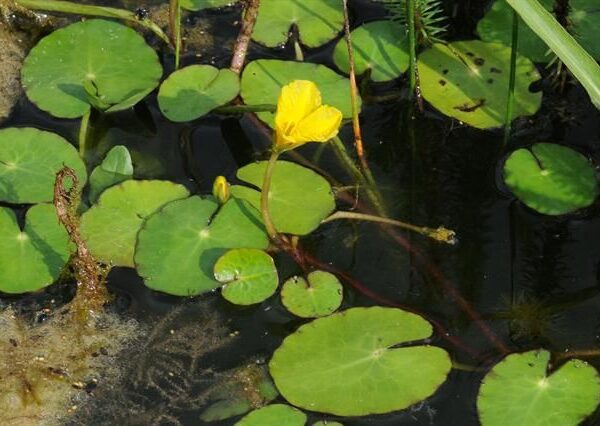
Yellow Floating Heart
(Nymphoides peltata)
Species at a Glance
Yellow Floating Heart is an aggressive aquatic perennial plant that was introduced as a garden ornamental from eastern Asia. It has since spread throughout the United States and Canada, forming dense mats of vegetation in the water that exclude native species and alter the ecology of waterways.
Species Description
The shiny green leaves of Yellow Floating Heart are heart-shaped and float on the water’s surface, supported by slender stalks. They are typically rippled or slightly wavy along the edges and often display reddish-purple blotches. They are alternately arranged along the main stem and oppositely arranged along the flowering stem, ranging in size from 5 to 15 cm (2 to 6 inches). From June to October, bright, yellow flowers bloom just above the water’s surface, either singly or in clusters of up to five. Each flower has five distinct, fringed petals, accompanied by five sepals and five stamens. The plant produces fruit capsules approximately 2.5 cm (1 inch) in size, each containing numerous flat, oval seeds with hairy edges. When mature, the capsules split open, enabling the seeds to float across the water. Yellow Floating Heart is rooted to the bottom and produces long, branched stems that can extend 1 meter (3 feet) or more.
Native & Introduced Ranges
Native to Eurasia and the Mediterranean region, Yellow Floating Heart was introduced as an ornamental plant from eastern Asia. It can be found throughout Pennsylvania.
Biology & Spread
A popular aquarium plant, Yellow Floating Heart can be easily purchased in water garden specialty stores and online. However, this plant often spreads beyond cultivation when it escapes outdoor water gardens during flooding events or is deliberately discarded into natural waterways. Since Yellow Floating Heart spreads both by seed and fragmentation, pieces of plant and seeds can be moved to new areas on water currents, or as they attach onto the feathers or fur of waterfowl and other wildlife.
Habitat
Yellow Floating Heart is commonly found in slow moving waters about 0.5-4 m (1.5-13 ft) deep, such as rivers, lakes, reservoirs, ponds, and swamps, and can even grow on damp mud.
Impacts
Threat to Biodiversity
Yellow Floating Heart forms dense mats of floating leaves that reduce water flow, block sunlight, lower oxygen levels, and disrupt natural nutrient cycles. As these colonies grow, the decomposition of large amounts of plant material depletes dissolved oxygen. Yellow Floating Heart also outcompetes native vegetation, reduces biodiversity, and alters habitat conditions for fish and other wildlife
Health
The thick mats of Yellow Floating Heart make recreational opportunities such as angling, boating, swimming, and paddling difficult.
Prevention & Control
Preventing the introduction and spread of Yellow Floating Heart is the best way to protect natural habitats from harm.
- Know how to identify and report Yellow Floating Heart.
- Always check for and remove plants, mud, and debris from boats, trailers, clothing, and equipment before entering a water body and before leaving a water body.
- Drain all water from bait buckets, bilges, and live wells before transporting to new areas.
- Clean all gear and equipment with hot water (140°F or 40°C) or salt water, OR let boats and equipment dry thoroughly for at least five days before entering a new water body.
- When choosing plants for a pond or water garden, purchase from a licensed nursery and choose regionally native or non-invasive plants. Check with your state natural resource agency to confirm which plants to avoid for your region.
Resources:
- Block, T. A. and Rhoads, A.F. 2011. Aquatic Plants of Pennsylvania, University of Pennsylvania Press, Philadelphia, Pennsylvania, p. 145.
- Indiana Department of Natural Resources. 2005. Aquatic Invasive Species: Yellow floating heart.
- ImapInvasives (2021)



